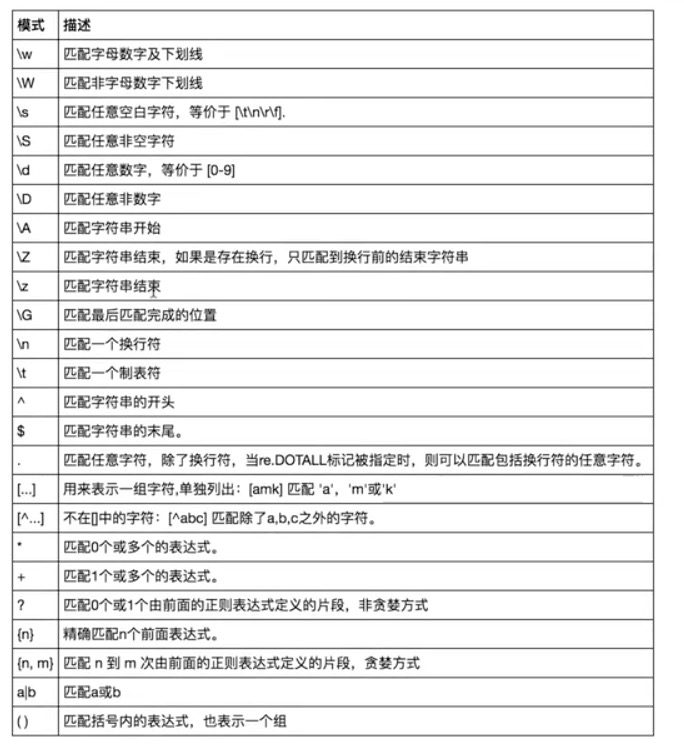常用内置模块(三)--subprocess、re
一、subprocess模块
进程:一个正在运行的程序
子进程:在父进程运行的过程中在其内部又开启了一个进程,即子进程。
作用:用于执行系统命令
os.system也可以获取当前的进程信息,但是它只能打印到屏幕,而无法进行其他操作,有局限性。
1 import subprocess 2 3 ''' 4 sh-3.2# ls /Users/egon/Desktop |grep txt$ 5 mysql.txt 6 tt.txt 7 事物.txt 8 ''' 9 10 res1=subprocess.Popen('ls /Users/jieli/Desktop',shell=True,stdout=subprocess.PIPE) 11 res=subprocess.Popen('grep txt$',shell=True,stdin=res1.stdout, 12 stdout=subprocess.PIPE) 13 14 print(res.stdout.read().decode('utf-8')) 15 16 17 #等同于上面,但是上面的优势在于,一个数据流可以和另外一个数据流交互,可以通过爬虫得到结果然后交给grep 18 res1=subprocess.Popen('ls /Users/jieli/Desktop |grep txt$',shell=True,stdout=subprocess.PIPE) 19 print(res1.stdout.read().decode('utf-8')) 20 21 22 #windows下: 23 # dir | findstr 'test*' 24 # dir | findstr 'txt$' 25 import subprocess 26 res1=subprocess.Popen(r'dir C:\Users\Administrator\PycharmProjects\test\函数备课',shell=True,stdout=subprocess.PIPE) 27 res=subprocess.Popen('findstr test*',shell=True,stdin=res1.stdout, 28 stdout=subprocess.PIPE) 29 30 print(res.stdout.read().decode('gbk')) #subprocess使用当前系统默认编码,得到结果为bytes类型,在windows下需要用gbk解码
二、re模块
1、什么是re
re是正则表达式,正则表达式是一些带有特殊意义的符号或符号的组合
2、常用匹配模式
最常用的有: 单个字符匹配: \w 字母数字下划线 \s 所有不可见字符(\n \t \f) \d 所有数字 . 除了\n以外的所有字符 ^ 字符串的开头,写在表达式的前面 $ 字符串的末尾,写在表达式的后面 范围匹配: [abc] 括号内的一个字符 a|b a或b 重复匹配 {} {,m}:0到m之间, {m,n}:m到n之前 , {m}:必须是m + 匹配1个或多个,会一直匹配到不满足条件为止,用“?”问号来阻止贪婪匹配(匹配最少满足条件的字符数) * 匹配0个或多个,会一直匹配到不满足条件为止,用“?”问号来阻止贪婪匹配(匹配最少满足条件的字符数) ? 匹配1个或0个 分组 () 匹配括号内的表达式,提取括号中的表达式,不会改变原来的表达式逻辑意义 取消分组 (?: )

1 import subprocess 2 3 ''' 4 sh-3.2# ls /Users/egon/Desktop |grep txt$ 5 mysql.txt 6 tt.txt 7 事物.txt 8 ''' 9 10 res1=subprocess.Popen('ls /Users/jieli/Desktop',shell=True,stdout=subprocess.PIPE) 11 res=subprocess.Popen('grep txt$',shell=True,stdin=res1.stdout, 12 stdout=subprocess.PIPE) 13 14 print(res.stdout.read().decode('utf-8')) 15 16 17 #等同于上面,但是上面的优势在于,一个数据流可以和另外一个数据流交互,可以通过爬虫得到结果然后交给grep 18 res1=subprocess.Popen('ls /Users/jieli/Desktop |grep txt$',shell=True,stdout=subprocess.PIPE) 19 print(res1.stdout.read().decode('utf-8')) 20 21 22 #windows下: 23 # dir | findstr 'test*' 24 # dir | findstr 'txt$' 25 import subprocess 26 res1=subprocess.Popen(r'dir C:\Users\Administrator\PycharmProjects\test\函数备课',shell=True,stdout=subprocess.PIPE) 27 res=subprocess.Popen('findstr test*',shell=True,stdin=res1.stdout, 28 stdout=subprocess.PIPE) 29 30 print(res.stdout.read().decode('gbk')) #subprocess使用当前系统默认编码,得到结果为bytes类型,在windows下需要用gbk解码

1 # 贪婪匹配 * + 不是固定的特殊符号 只是一种现象 2 # 会一直匹配到不满足条件为止 用问号来阻止贪婪匹配(匹配最少满足条件的字符数) 3 4 print(re.findall("\w+?", "ajshsjkdsd")) 5 # ['a', 'j', 's', 'h', 's', 'j', 'k', 'd', 's', 'd'] 6 7 print(re.findall("\w*?", "ajshsjkdsd")) 8 # ['', '', '', '', '', '', '', '', '', '', ''] 9 10 print(re.findall("\w+?s", "ajshsjkdsd")) 11 # ['ajs', 'hs', 'jkds'] 12 13 print(re.findall("\w*?s", "ajshsjkdsd")) 14 # ['ajs', 'hs', 'jkds']
1 # 贪婪匹配 * + 不是固定的特殊符号 只是一种现象 2 # 会一直匹配到不满足条件为止 用问号来阻止贪婪匹配(匹配最少满足条件的字符数) 3 4 print(re.findall("\w+?", "ajshsjkdsd")) 5 # ['a', 'j', 's', 'h', 's', 'j', 'k', 'd', 's', 'd'] 6 7 print(re.findall("\w*?", "ajshsjkdsd")) 8 # ['', '', '', '', '', '', '', '', '', '', ''] 9 10 print(re.findall("\w+?s", "ajshsjkdsd")) 11 # ['ajs', 'hs', 'jkds'] 12 13 print(re.findall("\w*?s", "ajshsjkdsd")) 14 # ['ajs', 'hs', 'jkds']
3、re模块的常用方法
(1).findall 从左往右查找所有满足条件的字符 返回一个列表
(2).search 返回第一个匹配的字符串,结果封装为对象
(3).match(不常用) 匹配行首, 返回值与search相同
(4).compile(不常用) 将正则表达式封装为一个正则对象,可以重复使用这个表达式
1 import re 2 3 print(re.findall('\w', src)) 4 # ['a', 'b', 'c', '_', 'd', '1', '2', '3', 'd', 'd', '5', 's', 'd'] 5 6 print(re.search('hello','weqwe hello dddd helllo dd')) 7 # <_sre.SRE_Match object; span=(6, 11), match='hello'> 8 9 print(re.match("hello"," world hello python")) 10 # None
4、分组
分组是从左边第一个左括号起,,index逐步增加,下面的1-4就是res=re.match(r"((a(b)c)(def))","abcdef")
1 ts = "abcdef" 2 reg = r"((a(b)c)(def))" 3 regex = re.compile(reg) 4 res = regex.match(ts) 5 print(res) 6 print(res.span()) # 匹配的结果的区间 7 print(res.group(0)) # abcdef 8 print(res.group(1)) # 1 -> 第一个() abcdef 9 print(res.group(2)) # abc 10 print(res.group(3)) # b 11 print(res.group(4)) # def 12 print(res.groups()) # ('abcdef','abc','b','def')



